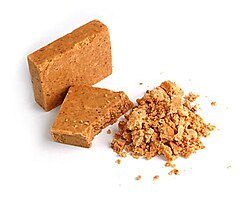 | |
| Place of origin | Brazil |
|---|---|
| Region or state | São Paulo |
| Main ingredients | Ground peanuts, sugar |

Paçoca (Portuguese: [paˈsɔka]) is a brazilian candy typical from São Paulo cuisine, originating in the interior of São Paulo.[1] It is made out of ground peanuts, sugar, honey and salt. Some recipes also add flour, such as corn flour, oat flour or cassava flour. Typical of the São Paulo Caipira cuisine, it is also present in other states in the country, such as Minas Gerais and Paraná, being either manufactured or home-made. Paçoca is also very common during the Festa Junina, an annual festivity that celebrates the caipira lifestyle in Brazil.[2] It is known for its distinct dry texture and sweet taste, and is one of the most beloved Brazilian candies.[3][4]
The state of São Paulo is the largest producer of peanuts in Brazil,[5] while the Santa Helena Group, created in 1942 in the city of Ribeirão Preto, is responsible for the production of Paçoquita, the most consumed paçoca in the country.[6][7] It is made in a cork or rectangular shape.[8] The group has also launched, in recent years, the creamy version and other versions, such as Paçoquita Diet.[9]
Origins
[edit]Paçoca in its present form was invented during the Colonial Brazil Period, but Native Brazilian peoples had recipes that mixed cassava flour with other ingredients prior to colonization. Those recipes were modified by the settlers, creating the current combination that uses sugar.[3]
Etymology
[edit]The word "paçoca" comes from the Tupi word pa'soka which means crumble.[citation needed] The term is also used for the savoury dish by the same name. Both are a mix of cassava flour pounded together with other ingredients – peanuts and sugar in the case of the sweet, and carne-de-sol (sun-dried-beef) for the savoury dish.[citation needed]
Production
[edit]The traditional artisanal process of making paçoca involves first roasting the peanuts, then grinding all the ingredients together using a traditional mortar (pilão).[10] In more modern manufacturing techniques, instead of a mortar, industrial blenders are used, and the Paçocas are later pressed into many shapes, most commonly square or cork shapes.
Variations
[edit]Some companies have created variations from the traditional Paçoca recipe, which include a diet version, with no sugar added, and a version with a concentration of peanuts.[10]

See also
[edit]References
[edit]- ^ "Festa Junina: Conheça a história por trás de 5 comidas típicas que não podem faltar". CNN Brasil (in Brazilian Portuguese). 2023-06-13. Retrieved 2025-05-26.
- ^ Rangel, Lúcia Helena Vitalli (2008-05-05). Festas Juninas Festas De são João: Origens, Tradições E História (in Brazilian Portuguese). Publishing Solutions. ISBN 978-85-61653-00-2.
- ^ a b Abicab, Brazilian industry association of chocolates, cocoa, peanuts, candies and derivatives Archived 2020-10-04 at the Wayback Machine (in Portuguese).
- ^ Amaral, A. O dialeto caipira (pdf). p. 139.
- ^ "Estrela do fitness, amendoim renasce no agro e triplica produção nacional em dez anos". Gazeta do Povo (in Brazilian Portuguese). Retrieved 2025-05-26.
- ^ "História do Amendoim". graosuniao.lwsite.com.br (in Brazilian Portuguese). Retrieved 2025-05-26.
- ^ "A Santa Helena, fabricante da Paçoquita e outras tantas delícias, completa 75 anos de história". Especial Publicitário - Santa Helena (in Brazilian Portuguese). 2017-05-25. Retrieved 2025-05-26.
- ^ "Conheça uma fábrica de paçoca, o doce típico das festas juninas" (in Brazilian Portuguese). Archived from the original on 2024-11-09. Retrieved 2025-05-26.
- ^ "Os bastidores da produção da Paçoquita Cremosa". Exame (in Brazilian Portuguese). Retrieved 2025-05-26.
- ^ a b Get to know a paçoca factory (in Portuguese).


 Français
Français Italiano
Italiano


